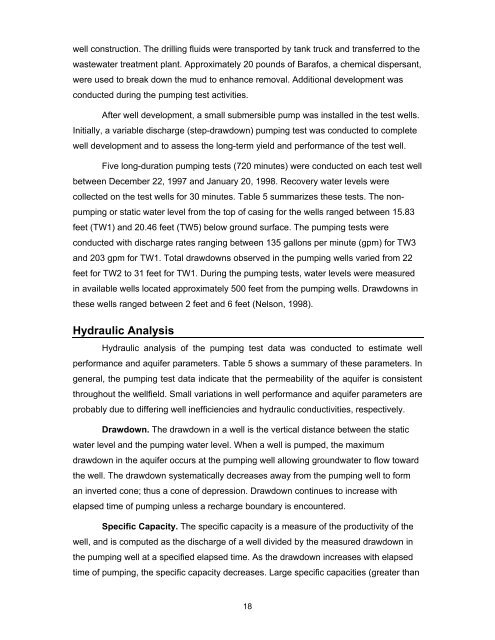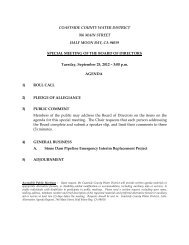Lower Pilarcitos Creek Groundwater Basin Study - Coastside ...
Lower Pilarcitos Creek Groundwater Basin Study - Coastside ...
Lower Pilarcitos Creek Groundwater Basin Study - Coastside ...
Create successful ePaper yourself
Turn your PDF publications into a flip-book with our unique Google optimized e-Paper software.
well construction. The drilling fluids were transported by tank truck and transferred to the<br />
wastewater treatment plant. Approximately 20 pounds of Barafos, a chemical dispersant,<br />
were used to break down the mud to enhance removal. Additional development was<br />
conducted during the pumping test activities.<br />
After well development, a small submersible pump was installed in the test wells.<br />
Initially, a variable discharge (step-drawdown) pumping test was conducted to complete<br />
well development and to assess the long-term yield and performance of the test well.<br />
Five long-duration pumping tests (720 minutes) were conducted on each test well<br />
between December 22, 1997 and January 20, 1998. Recovery water levels were<br />
collected on the test wells for 30 minutes. Table 5 summarizes these tests. The nonpumping<br />
or static water level from the top of casing for the wells ranged between 15.83<br />
feet (TW1) and 20.46 feet (TW5) below ground surface. The pumping tests were<br />
conducted with discharge rates ranging between 135 gallons per minute (gpm) for TW3<br />
and 203 gpm for TW1. Total drawdowns observed in the pumping wells varied from 22<br />
feet for TW2 to 31 feet for TW1. During the pumping tests, water levels were measured<br />
in available wells located approximately 500 feet from the pumping wells. Drawdowns in<br />
these wells ranged between 2 feet and 6 feet (Nelson, 1998).<br />
Hydraulic Analysis<br />
Hydraulic analysis of the pumping test data was conducted to estimate well<br />
performance and aquifer parameters. Table 5 shows a summary of these parameters. In<br />
general, the pumping test data indicate that the permeability of the aquifer is consistent<br />
throughout the wellfield. Small variations in well performance and aquifer parameters are<br />
probably due to differing well inefficiencies and hydraulic conductivities, respectively.<br />
Drawdown. The drawdown in a well is the vertical distance between the static<br />
water level and the pumping water level. When a well is pumped, the maximum<br />
drawdown in the aquifer occurs at the pumping well allowing groundwater to flow toward<br />
the well. The drawdown systematically decreases away from the pumping well to form<br />
an inverted cone; thus a cone of depression. Drawdown continues to increase with<br />
elapsed time of pumping unless a recharge boundary is encountered.<br />
Specific Capacity. The specific capacity is a measure of the productivity of the<br />
well, and is computed as the discharge of a well divided by the measured drawdown in<br />
the pumping well at a specified elapsed time. As the drawdown increases with elapsed<br />
time of pumping, the specific capacity decreases. Large specific capacities (greater than<br />
18



